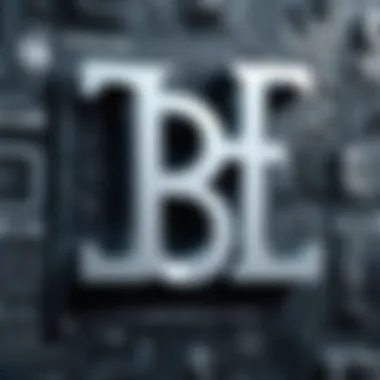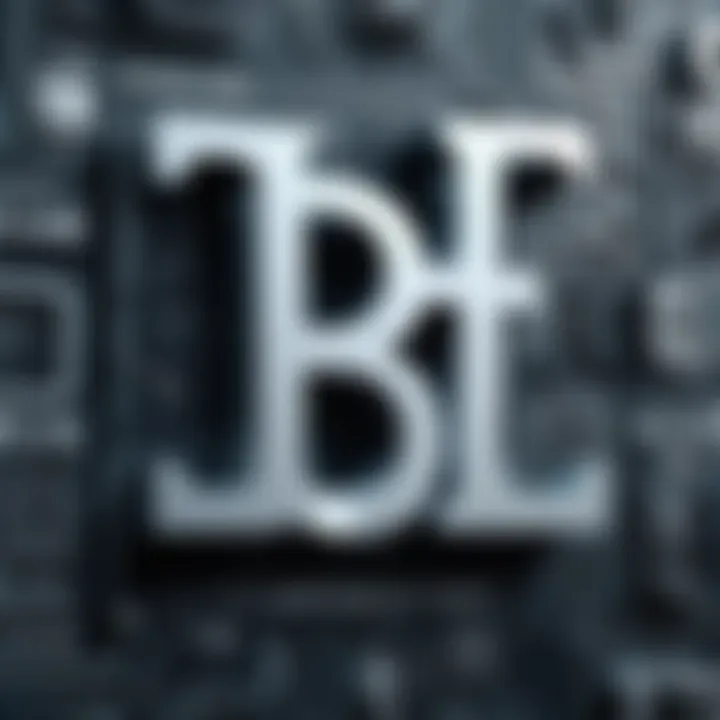Understanding Typography: Key Principles and Trends


Intro
Typography stands as one of the most pivotal aspects of design. Its influence permeates various fields including graphic design, advertising, and digital media. The arrangement of type not only affects readability but also shapes the aesthetic of a project. Understanding typography is essential for anyone who works in design or communication. It can enhance the effectiveness of a message and improve user experience.
This article delves into the core principles that govern typography, shedding light on best practices and ongoing innovations. By addressing both the historical context and contemporary advancements, readers will gain a nuanced perspective of typography's multifaceted role.
Technology Insights
Latest Tech Trends
The intersection of technology and typography is constantly evolving. Digital tools such as Adobe Fonts and Google Fonts have significantly broadened access to diverse fonts. Users can now explore vast libraries and incorporate appealing type styles with ease. These resources support typographic experimentation in web design, print, and multimedia.
Innovation in Tech
Emerging technologies like artificial intelligence are reshaping how designers approach typography. Software that utilizes AI can suggest font combinations and layouts, speeding up the design process significantly. Furthermore, responsive web design has prompted the development of variable fonts. These fonts allow for more fluidity and adaptability across different screen sizes, enhancing user experience.
Product Reviews
Among the noteworthy tools, Fontself Maker stands out for its unique approach. It allows users to create custom fonts in Adobe Illustrator. This level of creativity fosters innovation and can provide a brand's unique identity. Additionally, Glyphs and FontForge both offer robust platforms for typeface creation. Each of these tools plays a crucial role in facilitating modern typographic design.
Design Showcase
Creative Designs
Great typography is evident in various successful projects. Companies like Airbnb utilize distinctive typography to establish their brand voice. The choice of fonts and layout communicates their commitment to hospitality and warmth. Similarly, campaigns like the rebranding of Dropbox showcase the power of typography in narrating a company's story.
Architectural Trends
Typography has extended beyond traditional mediums and found its way into architectural design. Projects now often incorporate large, bold lettering on buildings. This creates an immediate visual impact while communicating messages effectively.
Graphic Design Inspiration
An exploration of contemporary graphic design reveals how typography is employed to grab attention. The use of layering, shadowing, and color gradients alongside letters can evoke emotion and action. Designers draw on classic principles but are not afraid to push boundaries.
Industry Spotlights
Designers to Watch
New talents in the typography sphere continue to emerge, pushing boundaries. Designers like Jessica Hische, known for her lettering work, and Erik Spiekermann, a key figure in type design, inspire both enthusiasts and professionals. Their contributions to the craft show how typography can evolve while maintaining its fundamental principles.
Event Coverage
Design Exhibitions Highlights
Events like Typo Berlin and the Type Directors Club Annual Exhibition attract designers and typographers from around the world. They present innovative works and foster discussions on best practices. Such gatherings serve as essential platforms for those invested in typography’s future, bringing fresh insights to the community.
Typography is not just about choosing a font; it's about creating a visual communication that resonates with target audiences.
Prelims to Typography
Typography represents a cornerstone of effective design and communication. In this section, the focus is on establishing a foundation for understanding how type shapes not only visual aesthetics but also functionality within various contexts. Typography affects user experience, brand voice, and the overall perception of information. It can transform a mundane message into something engaging or compromise clarity if mishandled.
The Role of Typography in Design
The role that typography plays in design cannot be overstated. It is more than just choosing a font; it involves a range of considerations that include the context of the content, audience perception, and intended emotional response. Effective typography communicates clearly and draws attention where it is needed most.
Typography aids in maintaining consistency across different mediums, ensuring that the identity of a brand is visually coherent. For instance, a user scrolling through a website will be more likely to engage with content that is well-structured, easy to read, and visually appealing. Similarly, print media relies heavily on type to convey messages in a way that captures the audience’s eye while preserving information integrity. A careful selection of typeface, size, and spacing will directly influence user engagement.
The Evolution of Typography
The evolution of typography mirrors advancements in technology and changes in design philosophies. Early typography hinged on the physical constraints of print, with typesetting manually implemented using movable type. Fast forward to the digital age, where typography has adapted to a variety of screens and devices.
The emergence of digital typography introduced new possibilities, such as variable fonts and dynamic rendering. As designers adapted to new technologies, typography gained flexibility and complexity. This evolution also mirrors shifts in aesthetic preferences and societal trends. For example, the minimalist design approach seen in recent years champions simplicity and clarity, shaping how type is utilized today.
As we continue to explore typography’s journey, it becomes evident that understanding its evolution is crucial. This knowledge allows designers to appreciate why certain styles resonate and how technological shifts influence current practices.


Fundamental Principles of Typography
The principles of typography serve as the foundation for invoking clarity and aesthetic value in design. The effective use of typography can enhance the communicative power of any design project. In this section, we will explore how these fundamental principles shape our understanding of typography, influencing everything from user experience to brand perception. Key elements include legibility, readability, contrast, and hierarchy.
Legibility and Readability
Understanding Legibility
Legibility refers to how easily individual letters can be recognized, distinguishing one from another. In typography, legibility is essential because it affects how quickly and easily a reader can absorb the intended message. Key characteristics of legibility include the shape of letters, spacing, and overall design. A typeface that enhances legibility, like Helvetica, is often chosen because its clean lines help maintain clarity. A major benefit of focusing on legibility is that it reduces cognitive strain on the reader, facilitating a smoother interaction with textual content.
Additionally, legibility is influenced by the medium it is displayed on, whether digital or print. High-resolution screens can afford intricate font designs without affecting legibility; however, low-resolution displays may not do the same. Thus, understanding legibility is crucial in digital typography, ensuring that content is accessible across various devices.
Factors Affecting Readability
Readability goes beyond individual letters; it encompasses how text flows and is positioned on a page. Factors affecting readability include font size, line length, and text alignment. Proper line spacing, or leading, greatly enhances readability. A common characteristic of readable text is generous spacing between lines, which empowers readers to navigate content effortlessly. The choice to focus on readability greatly benefits writers and designers since well-structured text can retain a user’s attention longer.
Moreover, readability also interacts with the intended audience and context. A more formal document might warrant a classic serif font, which typically enhances reader trust, while a tech blog could employ a sans serif for its modern touch. Recognizing the balance between aesthetic choices and practical considerations makes readability a central principle in typography that should not be overlooked.
Contrast and Color Theory
Contrast and color theory are crucial to establishing visual hierarchy in typography. Appropriate usage of color can make text pop or fade into the background. The right contrast ensures that the text remains readable while contributing to the overall aesthetic. Utilizing complementary colors presents a striking contrast that draws attention but must be done carefully to avoid overwhelming the audience.
Colors can also convey different emotional responses. A calming blue may evoke trust, while a bold red can incite urgency. Thus, the choice of colors and their contrasts heavily influences the viewer's interaction with the text, making it imperative for designers to consider these aspects thoughtfully.
Hierarchy in Typography
Establishing a Visual Hierarchy
Visual hierarchy is about arranging elements in a way that clearly communicates importance. A well-established hierarchy guides the reader's eye and helps convey the message effectively. Using varying font sizes and styles is a common method to establish this hierarchy. Headlines and subheadings, for instance, utilize larger, bolder fonts to draw attention, leading the reader through the narrative smoothly.
By creating a clear visual path, designers can ensure that important information stands out. The challenge lies in maintaining balance so that the design does not become overly cluttered. A structured visual hierarchy enhances usability and drives engagement, making it a vital aspect of effective typography.
Using Size and Weight Effectively
Size and weight are pivotal tools in typography, contributing to message clarity and emphasis. Larger text often conveys headings, while smaller text indicates subordinate information. Weight, in terms of boldness, further defines the importance of textual elements. Using size and weight judiciously can direct attention precisely where needed, enhancing readers' navigation through the content.
From a design perspective, combining different sizes and weights creates an aesthetically pleasing variance while emphasizing critical points. However, overusing size and weight can clutter visual space and distract readers, so finding equilibrium is essential for optimal effectiveness.Striking the right balance in size and weight not only beautifies the design but also enhances functionality, making it easier for users to engage with the content.
Remember that typography is more than just text; it’s a powerful tool that shapes perception and enhances communication.
Understanding these fundamental principles creates a structured approach to typography, guiding designers from concept to execution. A focus on legibility, readability, contrast, and hierarchy establishes a cohesive visual language that enhances the communication process.
Typographical Elements
Typographical elements play a critical role in the overall effectiveness and impact of design. The choice of typefaces, spacing, and alignment can influence how information is perceived by the audience. A well-considered typographical approach enhances readability and reinforces the intended message, making each element an essential consideration in both print and digital media.
Typefaces and Fonts
Serif vs. Sans Serif
Serif fonts have small lines or strokes at the ends of letters. They are often seen as traditional and elegant. On the other hand, sans serif fonts lack these embellishments and appear more modern and clean. Each typeface serves distinct purposes.
The preference for serif or sans serif usually depends on the context of use. For instance, serif fonts like Times New Roman are favored in printed materials for their readability at smaller sizes. Conversely, sans serif fonts such as Arial are commonly used in digital contexts due to their clarity on screens.
The choice between serif and sans serif goes beyond aesthetic; it can affect user engagement and message retention.
Display and Text Fonts
Display fonts are designed for maximum impact, often used for headings or posters, while text fonts aim at structure and readability for longer passages. Choosing the right font type influences not just aesthetics but also the tone of the communication.
For example, a display font could be a fun choice for marketing materials targeting younger audiences, whereas a text font like Georgia would work best in a professional report, ensuring that the information remains accessible and engaging without overwhelming the reader.
Spacing and Alignment
Kerning and Tracking
Kerning involves adjusting the space between individual letter pairs, while tracking adjusts the spacing uniformly across entire blocks of text. Proper kerning avoids awkward gaps that can lead to misreading or confusion in text interpretation.


This focus on spacing optimizes how audiences read content. Adjusting kerning can make a significant difference in branding materials and creative designs, contributing to a polished and cohesive appearance.
Line Spacing Considerations
Line spacing, or leading, refers to the vertical distance between lines of text. Well-balanced line spacing improves legibility and user experience, encouraging readers to engage with the content more effectively.
Selecting the right line spacing is crucial in typography. Tight line spacing can make text difficult to read, while too much spacing may interrupt the reading flow. Finding the right balance enhances clarity and keeps the audience's attention on the message.
The Use of Typography in Branding
Typography is a powerful tool in branding. The chosen fonts and their arrangement can communicate a brand's personality and values. For instance, luxury brands often prefer elegant serif fonts that evoke sophistication, while tech companies might lean towards sleek sans serifs to convey innovation.
Every typographical choice contributes to a brand's identity and can impact consumer perception and loyalty. By using typography strategically in branding, companies can create memorable interactions that resonate with their target audience.
Historical Perspectives on Typography
The field of typography is deeply rooted in history, reflecting a continual evolution of technology and culture. Understanding the historical perspectives on typography is crucial, as it not only highlights its relevance in modern design but also illuminates the ways in which past innovations shape contemporary practices. This section will explore two key milestones: the print revolution and the emergence of digital typography. Each of these moments represents significant shifts in how text is produced, perceived, and utilized in visual communication.
The Print Revolution
The print revolution, marked by Johannes Gutenberg’s invention of the movable type printing press in the 15th century, represents a profound turning point. This innovation democratized access to written content, making books more widely available and thus fostering literacy and education across Europe. The implications of this technology were immense. It transformed typography from hand-crafted manuscripts, which were labor-intensive and limited to wealthy patrons, to mass-produced works accessible to a broader audience.
The impact on design was also transformative. Typefaces began to emerge as distinct entities, leading to the development of styles like Blackletter, Roman, and Italics. Each variation allowed printers to choose how best to convey meaning and tone. Text layout evolved as well. Printers started to consider not only legibility but also aesthetic appeal, leading to the rise of the art forms we see in books and posters today.
This period also led to the formation of typography standards, contributing to the visual harmony in printed material. Different regions adopted distinct styles, influenced by local cultures and languages. Understanding this historical context enriches modern designers, offering them insights into typographic choices rooted in tradition and adapted over time.
Digital Typography Emergence
The emergence of digital typography in the late 20th century marked another critical juncture. With the advent of desktop publishing in the 1980s, typography shifted towards a more personal and accessible medium. Programs like Adobe PageMaker and later Adobe InDesign made it possible for individuals and small businesses to design and produce their own printed materials without needing expensive printing services.
This revolution also introduced the concept of fonts as digital files. As technology advanced, new font types emerged, including TrueType and OpenType, which provided more versatility and support for multiple languages. The ability to expand, compress, and customize font properties facilitated unprecedented freedom in design.
The internet further transformed typography, giving rise to web fonts and CSS, allowing designers to apply typography dynamically across various platforms. This flexibility also encouraged experimentation with type. Today’s designers use variable fonts, responsive typography, and other innovations that take into account the diverse devices on which content is consumed.
"The transition from print to digital typography illustrates not only technological advancement but also shifts in society’s relationship with text and design."
By exploring historical perspectives, designers can better appreciate how typography has adapted to cultural needs and technological changes. It allows for informed design decisions that respect the legacy while embracing future innovations.
Contemporary Trends in Typography
Contemporary typography is an ever-evolving field that reflects changes in technology, culture, and the expectations of audiences. Understanding these trends is crucial for designers looking to create relevant and impactful work. This section explores the latest advancements like responsive typography, variable fonts, and experimental typography, each serving to enhance communication through thoughtful design.
Responsive Typography
Responsive typography addresses the need for text to adapt to various devices and screen sizes. It ensures that legibility and aesthetic appear consistent, whether on a smartphone, tablet, or desktop. This adaptability is especially important as users increasingly engage with content across different platforms.
Adjusting to Different Screens
Adjusting to Different Screens means designing type that remains fitting regardless of screen size. A key characteristic of this approach is fluid typography, which scales the text proportionally based on the viewport. This is beneficial because it creates a seamless experience for users.
The unique feature of this method lies in its ability to provide an optimal reading experience, enhancing accessibility. However, one potential disadvantage is that it requires thorough testing across devices to ensure consistent presentation. Designers must also consider how font choices and sizes impact user experience across different contexts.
Flexibility in Design
Flexibility in design refers to the ability to tailor typography to suit various design needs and preferences. This topic emphasizes how fonts can dynamically change styles or weights based on user selections or contexts. This characteristic allows for unique presentations, fostering creativity and personalization in typography.
A significant advantage of this approach is that it enhances user engagement, allowing designers to create distinctive styles that adapt over time. However, designers should remain cautious about overwhelming users with too many changes that could lead to confusion or inconsistency. Balancing flexibility and maintainability is therefore essential.
Variable Fonts
Variable fonts represent a remarkable innovation that consolidates multiple style variations into a single font file. Designers can achieve diverse styles (such as bold, italic, and condensed) without having to load multiple assets. This aspect simplifies the design process and improves website performance because it reduces loading times—an increasingly crucial factor in web development.
Variable fonts offer designers unprecedented control over typography. Instead of relying on fixed styles, they can adjust weight, width, and other features dynamically. This flexibility provides a tailored experience to users, resulting in enhanced aesthetics and functionality.
Experimental Typography
Experimental typography pushes boundaries, allowing designers to explore creative expressions beyond traditional norms. This trend encourages innovation in type usage, resulting in unexpected compositions and visual features. It invites designers to play with forms, spacing, and animations to create engaging narratives through text.


Despite its exciting potential, experimental typography must remain mindful of legibility and usability. While creativity is essential, clashing features can arise if the text becomes too abstract or complex. Thus, the challenge lies in balancing creative exploration with readability.
Incorporating contemporary trends in typography not only refines visual communication but also aids in crafting unique and responsive designs that resonant with the audience.
By paying attention to trends such as responsive design, variable fonts, and experimental typography, designers can significantly enhance their work. Adapting to these developments is essential for anyone looking to remain competitive in an ever-changing design landscape.
Tools and Software for Typography
The role of tools and software in typography cannot be underestimated. As the landscape of design evolves, the available resources also change, affecting how we create and understand typography. These tools enable designers to manipulate type in ways that were not possible in the past. They provide essential capabilities for creating visually appealing and effective communication materials. Choosing the right software can enhance creativity, streamline workflows, and ultimately lead to better design outcomes.
Graphic Design Applications
When discussing graphic design applications, one cannot ignore their versatility. Softwares like Adobe Illustrator, Adobe InDesign, and Affinity Designer provide designers with powerful features for working with typography. These applications come equipped with a vast library of fonts and allow for precise font manipulation. Users can easily adjust kerning, leading, and tracking, which are crucial for ensuring optimal legibility and aesthetics.
Another important element is the ability to create custom fonts. FontForge and Glyphs are examples of applications that enable designers to create unique typefaces. This feature is particularly valuable for branding, as bespoke typefaces can convey a brand's identity effectively while helping it to stand out in a crowded market.
Web Typography Tools
Web typography tools have become vital as online content continues to expand. Google Fonts and Adobe Fonts offer extensive libraries of fonts that are easy to integrate into websites. These platforms allow developers to select diverse fonts that match their design vision while maintaining performance across devices.
Additionally, CSS properties like , , and facilitate precise control over how text appears on the web. This flexibility allows designers to ensure that typography not only looks good but is also functional, adapting well to various screen sizes and resolutions.
Having accessible web typography tools means that designers can focus on creativity without compromising user experience or loading times. Understanding these tools can fundamentally elevate anyone’s design project.
"Choosing the right typography tools is essential for every designer to ensure the creation of effective and aesthetically pleasing designs."
Practical Applications of Typography
Typography is more than a mere arrangement of letters on a page; it plays a crucial role in how information is communicated and perceived. In this section, we will explore the practical applications of typography, focusing on its significance in various fields such as web design, print media, and case studies that exemplify effective usage. Understanding these applications enables designers and communicators to leverage typography for maximum impact.
Typography in Web Design
In the modern digital landscape, web design hinges on effective typography. With the sheer volume of content produced daily, it is essential to ensure that text is not only legible but also engaging.
- Readability on Different Devices: Responsive design demands that typography adapts to various screen sizes and resolutions. Larger font sizes and appropriate line spacing are critical to maintain readability on mobile devices.
- User Experience (UX): A well-chosen typeface enhances user experience by guiding the reader through the content. It fosters a sense of hierarchy, making it easier for users to navigate and digest information quickly.
- Emotional Connection: Fonts convey emotions. For instance, a playful script may evoke a different response than a sterile sans serif. Selecting the right typeface aligns the message with the brand's identity.
Typography in Print Media
Even in a digital age, print media remains relevant. Typography in print requires meticulous attention to detail, as it directly impacts how information is absorbed.
- Clarity in Communication: Print materials must convey messages clearly. The choice of typeface, size, and style affects how effectively the text communicates its intended message.
- Aesthetic Appeal: A well-designed print layout with thoughtful typography can attract an audience's attention. It can elevate mundane content into something visually striking.
- Brand Consistency: For brands, maintaining consistent typography across print materials reinforces identity. This cohesion helps consumers recognize and trust the brand.
Case Studies in Effective Typography
Analyzing practical examples of effective typography reveals lessons that can be applied to various projects.
"Typography is the craft of endowing human language with a durable visual form." - Robert Bringhurst
- Case Study: The Guardian: This publication uses clean, modern fonts that adapt well to both their print and digital formats. Their typographical choices facilitate engagement and readability across platforms.
- Case Study: Airbnb: The platform employs a distinctive typeface that aligns with its brand personality, enhancing user experience and fostering trust among its users.
- Additional Examples: Various companies such as Apple and Google have demonstrated how typography can enhance brand recognition and user experience across diverse media.
In summary, practical applications of typography are paramount. They not only influence design but also affect user engagement and brand perception. By understanding its role in web design, print media, and analyzing effective case studies, designers can harness its power for clearer communication.
The Future of Typography
Typography is the silent architect of communication. It shapes not just how we view text, but how we interpret it. As we advance into an era dominated by technology and digital platforms, the future of typography presents both exciting possibilities and significant challenges. Understanding these aspects is crucial for designers and brands aiming to stay relevant in an ever-evolving landscape.
AI and Typography
Artificial Intelligence is redefining typography in various ways. From automatic font generation to smart layout adjustments, AI tools enhance creativity and efficiency. Tools like Adobe's Sensei employ machine learning to suggest better designs and optimize typography based on the context. The benefits of AI in typography include:
- Personalization: AI can analyze user data to customize typography styles that resonate with specific audiences. This leads to more effective branding and user engagement.
- Efficiency: Automated tools decrease the time spent on tedious tasks such as kerning and alignment. This allows designers to focus on more complex creative processes.
- Accessibility: Enhanced font readability through AI-led adjustments helps reach diverse audiences, ensuring that designs are inclusive.
However, one must be cautious. The reliance on AI could lead to a homogenized design language if designers do not infuse their unique perspectives into the creative process. Keeping the human element at the forefront is essential.
Augmented Reality and Typography
Augmented Reality (AR) is set to transform how we interact with typography. By merging the digital and physical worlds, AR allows typography to transcend traditional boundaries. Consider these developing facets:
- Interactive Typography: Fonts can engage users beyond static text. With AR apps, words can float in space, change sizes, and even animate, capturing attention and enhancing user experiences.
- Contextual Relevance: AR can provide real-time context through typography. For example, a sign in a museum might change the information displayed based on the viewer's location, providing a dynamic interaction that static text cannot achieve.
- Brand Storytelling: Brands can utilize AR typography to narrate their stories in compelling ways. Typography can pop up in physical spaces, linking readers directly to brand experiences or products.
The integration of AR with typography encourages designers to think outside the box. It enhances interactivity, making designs more engaging and memorable.
The evolution of typography through AI and AR offers innovative paths for communication. It challenges designers to embrace technology while maintaining their individual creativity and connection with audiences.







